- Home
- Raymond Benson
High Time To Kill Page 8
High Time To Kill Read online
Page 8
The Jaguar was twenty miles from “the Ring,” the busy roadway that encircled the main city, when Bond noticed two high-speed motorcycles gaining on him. They appeared to be identical dark green Kawasaki ZZ-R1100 superbikes. Bond was familiar with the vehicles and knew them to be powerful, heavy, and very fast. Obtaining an extra boost from a ram-air system that ducted cool air from a slot in the fairing nose to a pressurized air box, they could easily keep up with the Jaguar.
A third ZZ-R1100 pulled out onto the highway from an entrance ramp in front of him just as the other two reached a point fifty yards behind Bond’s car. He was certain that they were performing rehearsed maneuvers—the timing was just too skillful. Bond sat straight in the seat, gripped the wheel, and increased his speed to ninety in order to overtake the motorcycle in the right lane in front of him. It didn’t help that traffic was moderately heavy.
Bond veered into the center lane so that he could pass the rider and get a good look at him. At that angle he appeared to be dressed in army-fatigues and an olive green crash helmet, neatly color coordinated with the bike. Was it a costume? Perhaps the three riders were part of some kind of auto show and weren’t dangerous at all?
The motorcycle suddenly swerved into Bond’s lane, preventing him from passing. Bond was forced to ease his speed down to seventy, which gave the two men behind him an opportunity to close the gap.
Now at a distance of thirty feet, the two pursuers were side by side in the same lane behind Bond. Bond swerved into the far left lane, but all three motorcycles followed suit as if they were operating by remote control.
There was no doubt now, Bond thought, these men had to be professionals. He changed lanes again, back to the center, and then to the far right, as the superbikes immediately adjusted to pin him in again.
Bond was peering at the riders behind him in the rearview mirror when he noticed a sudden puff of black smoke just below one of the windshields. He felt a series of fast, hard jolts in the back of the Jaguar.
Bond set his jaw. The bastard had fired a volley of machine gun bullets at his petrol tank.
The two riders looked at each other as if to ask “Why didn’t the car explode?” Bond allowed himself a smile. The body’s chobam armor was impenetrable and had reactive skins that exploded when hit, thereby deflecting the bullets. The metal was self-healing by virtue of viscous fluid.
Apparently able to communicate with each other via headsets, the riders prepared a new strategy. One of the men behind Bond pulled into the right-hand lane and sped up so that he was parallel to the Jaguar. The rider looked at Bond and mouthed what must have been an unsavory epithet.
Bond pulled the wheel sharply to the right, ramming into the motorcycle. The Kawasaki was knocked off the road and onto the shoulder, where it fell on its side and skidded for a hundred feet before stopping. Bond had hoped the cycle would be completely wrecked, but the rider apparently wasn’t harmed and would be back on the road in a minute or two. He moved the J mechanism into manual mode and floored the accelerator. The Jaguar shot ahead of the front cycle, then maneuvered around slower civilian vehicles to put some distance between him and the green bikers. Bond hoped that he wouldn’t have to use deadly force against these men on such a busy highway, and wondered if he should telephone the Belgian police on his mobile phone.
The remaining two cyclists darted in and out of the traffic to catch up with Bond. Road repairs had caused the far left lane to be closed at one point. Now relegated to only two lanes, the traffic was thicker. Bond sped up and soon found himself tailgating two ten-wheel lorries that were blocking both lanes. They were both traveling at unsafe speeds, attempting to outrace each other. Bond honked the horn, hoping that one would pull into the other’s lane. The driver in the lorry in front of himblasted his own horn, challenging Bond to do something about it.
“Defense systems on,” Bond said aloud. One of the new features that Q Branch had put in the car was voice activation for all systems—phone, audio, lighting, and, of course, weaponry. An icon flashed on the telematics screen on the dashboard, indicating that Bond’s command had been executed.
“Activate flying scout,” he said. An outline of the scout, a device the size of a small model airplane, appeared on the screen. It was stored underneath the chassis until it was activated from inside the car. The scout could fly out from under the vehicle and reach an altitude of Bond’s choosing. It was steerable by joystick or satellite navigation.
The display changed to read SCOUT READY.
“Launch scout,” he commanded. He felt a sudden whoosh behind the Jaguar as the scout ejected from its bay. The batlike vehicle soared out and up into the air, then turned so that it was traveling thirty feet above and parallel with the Jaguar. The two motorcyclists couldn’t believe their eyes. One of them pointed to the scout and shouted something.
Keeping one hand on the wheel, Bond used his left hand to manipulate the joystick. He sent the scout forward and increased its speed so that it would move up beside the lorries, which were still barreling down the road neck and neck.
Bond lowered the scout slowly without decreasing its speed. Like a hummingbird, the aircraft gently positioned itself so that it was flying at door level in between the two lorries. The driver of the lorry on the right looked to his left and saw the strange contraption flying just outside his window. He gasped and almost ran off the road, but he managed to straighten the wheel in time.
The chobam armor, which also coated the scout, was quite effective for battering purposes. Bond moved the joystick so that the plane swung to the right with great force, shattering the driver’s window with its wing. He pulled the scout up and out of the way as the driver then completely lost control of the lorry. It careened off the road, over the shoulder, then turned over and crashed into the ditch.
That should get the attention of the police, Bond thought. He increased the speed and shot past the other lorry, whose frightened driver had dropped his speed to forty. The scout, meanwhile, returned to its place above the Jaguar.
Surprisingly, a stretch of road ahead of Bond was relatively traffic free. He opened up, hoping that the two pursuers would follow him into the clear area. In a moment he saw them zoom past the lorry that he had left behind. One Kawasaki was gaining fast, the other dropping back a bit.
“Prepare silicon fluid bomb,” Bond said. Another new feature on the car, the oil or silicon fluid explosives could be dropped from the rear bumper into the path of a pursuing vehicle. They were more direct and caused “cleaner” damage than the Jaguar’s heat-seeking rockets, which were meant for heavier targets.
The Kawasaki moved into position behind Bond, and the rider fired its machine gun again. Bond felt the impact ricochet off the back of the car, then said, “Launch bomb.”
A device the size of a compact disc dropped out of the bumper and rolled out onto the road. The rider on the motorcycle saw it and attempted to swerve around it, but it was too late. The device exploded with a tremendous blast, sending pieces of the Kawasaki and its rider into the air. The highway was soon littered with black smoke, burnt metal, and seared body parts.
The other rider pulled into the left lane and zigzagged around the debris, staying on Bond’s tail. When he was in range, he fired his guns at the Jaguar, too.
“Ready rear laser,” Bond said. The icon appeared on the screen.
The cycle moved closer, the bullets still flying. One of the back tires burst, but the car was engineered so that it could run on flats.
“Count of three for one-second laser flash,” Bond said. “One … two … three.”
The sudden bright light confused the rider behind him. At first he thought it was glare from the sun, bouncing off a piece of reflective metal on the back of the Jaguar. Momentarily blinded, he kept the handlebars straight, hoping that his sight would clear in a few seconds—but then the pain began. His eyes felt as if they were being burned with hot pokers, and then there was nothing but darkness. The laser flash had permanently s
eared his retinas.
Bond watched in the rearview mirror as the Kawasaki wobbled and veered to the left. It crashed through the repair lane and guardrail, then slid into the oncoming traffic on the other side of the road. Horns blared and drivers slammed on their brakes. Several cars crashed into one another in an effort to avoid hitting the motorcycle, but the Kawasaki was run over by a van and dragged at least two hundred yards before both hunks of metal came to a stop.
Bond could hear sirens in the distance. They were coming from the city, the opposite direction from which he was traveling. He looked in the rearview mirror and saw that the third motorcycle, the one he had bumped off the road earlier, had rejoined the chase. Bond presumed correctly that this rider was unaware of the flying scout soaring above the Jaguar at a safe distance. He gently pushed the joystick so that the scout decreased speed, then made an about-face. Bond brought the scout down to a level equal to that of the cyclist, then pushed the throttle. It shot back toward the cycle at full speed.
The rider gasped when he saw the strange, birdlike thing headed straight for him. He barely had time to scream.
The scout met the cycle head-on, knocking the rider off the bike. Bond pulled the scout up and away as the motorcycle skidded on its side and eventually came to rest in the ditch.
“Prepare to dock scout,” Bond said as he maneuvered the remarkable device back behind the Jaguar.
He gave the command, and the bird pulled underneath the chassis and locked into place just as Bond entered “the Ring.” Blending in with heavy traffic, the Jaguar safely drove past the power plants, car dealerships, and business parks that dotted the landscape.
Bond activated the mobile speaker phone, then called out the speed dial code for headquarters in London. After the normal security checks, he was put through to Bill Tanner’s office. His secretary answered and told Bond that M and the Chief of Staff were off-site at a meeting.
“Damn,” he said. “Put me through to Helena Marksbury please.”
In a moment he heard his personal assistant’s lilting voice.
“James?” she answered. Bond could hear her apprehension. She probably had looked forward to a few days of his absence.
“Helena, we have a problem,” he said. “Someone knew I was on my way to Brussels, and three men on motorcycles tried to kill me.”
“My God, James, are you all right?” she asked with concern.
“Yes. I need you to get this message to the Chief of Staff immediately. He and M are at a meeting off-site.” He gave her the details. “Find them and tell them that a Code Eighty is in effect.” This meant that a security breach had occurred.
“Right,” she said. “I’m on it now, James. Are you in Brussels?”
“Almost. I’ll talk to you later.”
“Be careful,” she said, then rang off. Despite the awkward situation that existed between them, Bond was thankful that Helena was capable of carrying on in a professional manner.
He soon got off the Ring road and onto Industrial Boulevard, which led toward the center of Brussels, and once again offered a silent thanks to Major Boothroyd and the rest of Q Branch.
It was a beautiful, sunny, spring day. Bond parked the car in a garage near the Grand Place, the magnificent square that is considered the centerpiece of Brussels. Bordered on all four sides by icons of Belgium’s royal history, the Grand Place is a dazzling display of ornamental gables, gilded facades, medieval banners, and gold-filigreed rooftop sculptures. The Gothic Town Hall, dating back to the early 1400s, remains intact; the other buildings, the neo-Gothic King’s House and the Brewers Guild House, date from the late 1600s. The Brussels aldermen continue to meet in the Town Hall, the exterior of which is decorated in part by fifteenth- and sixteenth-century insider’s jokes. The sculptures include a group of drinking monks, a sleeping Moor and his harem, a heap of chairs resembling the medieval torture called strappado, and St. Michael slaying a femalebreasted devil. Bond had once heard a story that the architect, Jan van Ruysbroeck, committed suicide by leaping from the belfry when he realized that it is off center and has an off-center entrance.
It was nearly two o’clock. Bond put on a pair of Ray-Ban Wayfarers sunglasses that would identify him to his contact, then walked southwest through the colorful and narrow cobblestoned streets to the intersection of Rue du Chêne and Rue de l’Étuve. There, surrounded by camera-snapping tourists, was the famous statue of the urinating little boy known as Manneken-Pis. Although not the original statue (which was subject to vandalism and was removed), the current idol is an exact replica and is perhaps the most well known symbol of Brussels. Bond didn’t know what its origins were, but he knew that it dated from the early 1400s and was perhaps the effigy of a patriotic Belgian lad who sprinkled a hated Spanish sentry who had passed beneath his window. Another story was that he had saved the Town Hall from a small fire by extinguishing it using the only means available. Today, “Little Julian,” as he is called, was dressed in a strange red cloak with a white fur collar. Louis XV of France began the tradition of presenting colorful costumes to the little boy and since then he has acquired hundreds of outfits.
“He must have a very large bladder to keep peeing like that,” a female voice said in English, but with a thick European accent.
Bond glanced to his left and saw an attractive woman dressed in a smart beige trouser suit and a light jacket. She was wearing Ray-Bans; had strawberry-blond, short, curly hair; a light cream complexion; and her sensual lips were painted with light red lipstick. A toothpick lodged at the corner of her mouth. She appeared to be around thirty, and she had the figure of a fashion model.
“I’m just glad this isn’t considered a drinking fountain,” Bond replied.
She removed the sunglasses to reveal bright blue eyes that sparkled in the sunlight. She held out her hand and said, “Gina Hollander. Station B.”
Bond took her hand, which felt smooth and warm. “Bond. James Bond.”
“Come on,” she said, gesturing with her head, “let’s go to the station house, then we’ll get your car and take it to your hotel.” Her English was good, but Bond could tell she wasn’t terribly comfortable with it.
“Parlez-vous français?” he asked.
“Oui,” she said, then switched back to English, “but my first language is Dutch, Flemish. You speak Dutch?”
“Not nearly as well as you speak English,” he replied.
“Then let’s stick to English, I need the practice.”
She was not beautiful, but Bond found her very appealing. The short, curly hairstyle gave her a pixielike quality that most people would describe as cute, an adjective Bond always avoided. She was petite, but she walked with confidence and grace, as if she were six feet tall.
“Which is my hotel, by the way?” he asked.
“The Métropole. It’s one of the best in town.”
“I know it. I’ve stayed there before.”
“Our target is staying there, too.”
“Oh?”
“I’ll tell you all about it when we get to the station house. It’s just over here.”
She led him into a very narrow street off Petite Rue des Bouchers, near the famous folk puppet showcase Théâtre Toone, and into a pastry shop. The smell of baked goods was overpowering.
“Care for a cream puff?” she asked.
He smiled and said, “Later, perhaps.”
Gina said something in Flemish to the woman behind the counter, then led Bond through a door, into the kitchen, where a large, sweating man was loading a tray of rolls into an oven. She went through another door to a staircase that led to a second-floor loft: the headquarters of Station B.
It was a comfortable one room/one bathroom flat that had been transformed into an office, just barely large enough for an operative and some equipment. Besides the usual computer gear, file cabinets, fax machine, and copier, there was a sofa bed, a television, and kitchenette. It was decorated with a decidedly feminine touch, and there was an abundance of B
elgian lace draped over the furniture.
“I don’t live here, but the sofa bed is handy if I ever have to stay late,” she said as they entered. “Have a seat anywhere. You want something to drink?”
“Vodka with ice, please. Before we do anything, though, I have to call London. We have a little problem.”
“What’s that?”
“We have a security leak. Someone knew I was coming. I was attacked on the E19.”
“Really? That was you? I heard about the accidents on the road! Are you all right?”
Bond removed his gunmetal case and took out a cigarette. He offered one to her, but she shook her head.
“I’m fine, but they’re not,” he said. “Three men on motorcycles. Came from nowhere, tried to kill me. I’m afraid a lorry was smashed, and a few passenger cars, too. I tried to call London earlier, but everyone was in a bloody meeting.”
She pointed to the desk. “I assure you there’s been no security breach here. The phone is there. Please.”
Bond reached for the phone and removed from the inside pocket of his jacket a device that looked like a small black light meter. He pulled out a three-inch antenna and flicked a switch. He scanned the phone with the detector.
“I do that every morning, Mr. Bond,” Gina said. “With more sophisticated equipment.”
“I doubt it could do much better than this little toy,” Bond said, satisfied with the reading he got. The CSS 8700V Bug Alert was usually accurate. “Sorry, I had to check.”
“That’s all right.” She went to the kitchenette to get the drinks.
Bond picked up the phone and called the secure line again. This time Tanner picked up.
“Hello, James, sorry I was away earlier. M wanted me to—”
“Never mind, did Helena give you the message?”
“Yes, she did. We’re looking into it now. How many people knew you were on the way to Brussels?”

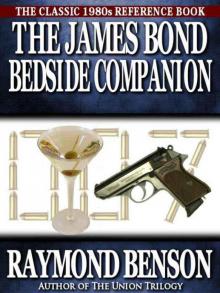 The James Bond Bedside Companion
The James Bond Bedside Companion The Black Stiletto's Autograph
The Black Stiletto's Autograph Blues in the Dark
Blues in the Dark Zero Minus Ten
Zero Minus Ten The Black Stiletto
The Black Stiletto Doubleshot
Doubleshot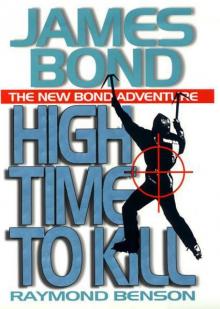 High Time To Kill rbb-3
High Time To Kill rbb-3 Bond Movies 07 - Die Another Day
Bond Movies 07 - Die Another Day The Facts Of Death
The Facts Of Death Midsummer Night's Doom
Midsummer Night's Doom Blast from the Past
Blast from the Past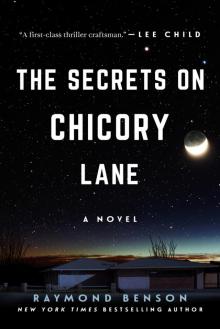 The Secrets on Chicory Lane
The Secrets on Chicory Lane High Time To Kill
High Time To Kill The Black Stiletto: Black & White
The Black Stiletto: Black & White The World Is Not Enough jb-1
The World Is Not Enough jb-1 Zero Minus Ten rbb-1
Zero Minus Ten rbb-1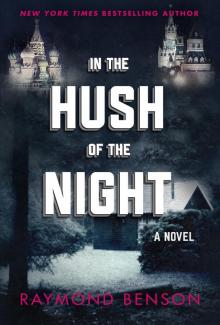 In the Hush of the Night
In the Hush of the Night The Black Stiletto: Stars & Stripes
The Black Stiletto: Stars & Stripes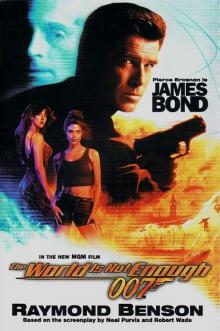 Bond Movies 06 - The World Is Not Enough
Bond Movies 06 - The World Is Not Enough The Rock 'n Roll Detective's Greatest Hits - A Spike Berenger Anthology
The Rock 'n Roll Detective's Greatest Hits - A Spike Berenger Anthology Never Dream Of Dying
Never Dream Of Dying